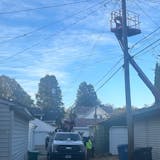Every community across the Twin Cities could reduce its carbon footprint and save local business owners money by adopting an outdoor lighting code similar to the city of Plymouth's.
The goal of the Plymouth code, based on the Model Lighting Ordinance developed by the International Dark Sky Association, is to establish consistent lighting limits that minimize glare and obtrusive light. A beneficial side effect is reduced energy consumption and a lower carbon footprint for parking lots.
Lighting zones, the key to Plymouth's lighting code, reflect the base or ambient light levels desired by a community. Lighting Zone 0 (LZ0), the lowest light level, is designed for natural environments where lighting impacts include disturbing the biological cycles of plants and animals. LZ4, at the other extreme, is for dense commercial areas with active nightlife. Lighting Zones 1 through 3 apply in most residential and commercial districts in a city. Those middle zones offer the most opportunity for cities to reduce their carbon footprint by allowing or requiring businesses to turn off unneeded lights.
For decades consumers have used motion detectors, timers, light sensors and dimmers that allow them to control when a light should be on and how bright it should be. Those same devices, scaled up for the power needs of parking lot lights, are available to business. But in most municipalities, city ordinances prohibit dimming or turning off a parking lot light after dark, even if the only object being protected is pavement.
Changing those codes would allow businesses to use motion detectors to light up only the area around a late-working employee leaving a building. Dimmers could reduce the amount of light on distant empty parking lots; timers can turn off lighting that isn't necessary for the effective use of security cameras.
What about LED lights? We'll always have to light parking lots during business hours and LEDs have enormous potential to reduce the cost and carbon emissions of lighting. But LEDs aren't carbon free. A single high-efficiency LED parking lot light burns nearly 150 watts of electricity per hour. In an average year the bulb will burn 12 hours per night, consume 657 kilowatt-hours of electricity and require enough coal to generate more than 1,300 pounds of carbon dioxide emissions.
Xcel Energy has been a national leader in replacing coal-generated power with cleaner renewable sources of energy. But building wind and solar generators to light up empty parking lots is wasteful. It would be better to use that power to run hospitals, businesses and refrigerators.
From a carbon emissions standpoint alone, the impact of better outdoor lighting codes is dramatic, but there are also other benefits. A Los Angeles Times commentary by Eric Betz ("Why we must dim bright light at night," reprinted in the Star Tribune on Aug. 24, 2015) pointed out that excess lighting doesn't deter crime but does affect the circadian rhythms of humans and wildlife. "[N]ighttime light exposure is a risk factor for some cancers, diabetes, heart disease and obesity," Betz wrote, adding "The American Medical Association has already recommended that cities reduce light pollution."

